#regionalist styles
Explore tagged Tumblr posts
Text
Andrew Wyeth: The Helga Pictures :: John Wilmerding
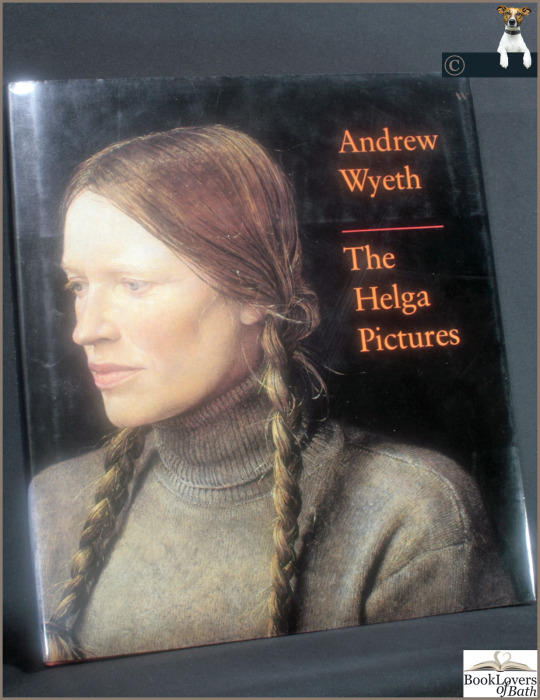
View On WordPress
#0-8109-1788-2#american painters#american portraits#art pennsylvania#books by john wilmerding#female artists#first edition books#interpretation artists#interpretation painters#interpretation painting#j carter brown#national gallery art washington#realist painting#regionalist styles#women artists
0 notes
Text
In Which I Ramble About Pavitr's Character Design and the Indian Cultural Stuff Related to It
DISCLAIMER: I'm an Indian, and these are all my thoughts and analyses, but I'm also just one person and by no means am I speaking for everyone. I am not all knowing, and I am not immune to being wrong sometimes. These points are all my own thoughts and stuff that I know through my lived cultural experiences and some history and book knowledge, but I've not particularly researched any of these. I'm just out here giving my take from what I know. This is mostly just going to be me rambling, okay? Okay. Let's go!
Anyway okay so I just wanna go from the top down:
No. 1:
First of all his hair
His fucking hair
This is one aspect that i k n o w I'm overthinking and probably wasn't as significantly thought out in the design but it just Spoke to me and by all accounts I'm not the only one
But I'm so glad we have him with his thick gorgeous fricking hair, especially them being like curly/wavy and slightly long instead of straight and cropped or whatever
Like. Indians usually have very thick and luscious hair, not everyone ofc but generally it's a thing, and it's considered a point of pride to have long dark thick hair.
And the thing is for the longest time the beauty standard in India was to have very straight and shiny hair, all the actresses and heroes were doing it, even though that's literally not the realistic case for a lot lot LOT of Indians. There's a pretty big variety of hair texture in India; some of it is regionally concentrated too, eg. in South India you get a lot of frizzy, tightly coiled hair that's rough textured, whereas curly hair is usually silkier and looser curled as you go Northwards,, Bengalis tend to have very wavy thick hair,, etc. By no means a rule or anything, it's just a thing that there's a lot of curl variety and a lot of it was for the longest time considered ugly and unkempt (there are some classist/regionalist elements to this stereotype also unsurprisingly) still is by some people,,, bc the standard was Shiny Straight Hair. It's a standard that's slowly shifting. It's currently leaning more on the wavy and voluminous side. But it's def a thing still.
All that to say, it makes me so so happy to see Pav with his curly-ish lush hair that he wears with such pride and style,, that are a symbol of his own pride and self care too!!!
Also the line about "coconut oil, prayers and good genetics" - I LOVE THAT REFERENCE AHAHABSSK, using coconut oil for the hair is a very common thing here, it's so so good for the hair and the scalp alike and it's relaxing to massage it in too.
I've seen people try to write Pavitr in fics as "quickly brushing some coconut oil through his hair" as part of his morning routine and. Um. That's not how it's done askaskjas, I don't mean to be rude to the writers at all, everyone does the best with what they know and no one knows everything, but also practically speaking that would be greasy and awful.
There are multiple ways to apply coconut oil, ofc. Coconut oil is often massaged into the scalp and rubbed into the hair like an hour before washing, sometimes with lemon juice mixed in, and then washed off when bathing. Some people, especially those with drier and finer hair, apply it as a regular after-hair-wash thing, too, but even so it needs to be rubbed in.
A really beloved thing we have is coconut oil champis, too! This is basically when you sit down cross legged in front of youe mother/grandmother, and she massages the coconut oil into your scalp and hair in a way that literally cures all tension and headaches and leaves your head reeling and is so so good for hair and stress and everything. It's a family bonding thing more than just a hair routine. It's not always done by the mom/grandmother ofc, it's just how most of us first experience it, and they have a technique that none of us can ever quite replicate to the same effect later. As we grow up, we often do it for ourselves and for others. It's a weekly or monthly or even just occasional thing depending on who you ask. But yeah that reference was great I love it dearly!

Also about the hair length
So in the current modern "civilized" standard (Indian schools and society in general tend to do a lot of shit trying to assimilate us into western culture and stamp out our own,, for example all my life I've been in schools where speaking Hindi and Telugu and stuff in class or in the hallways was Wrong and Forbidden and We Must Speak Only In English Bc We Are Educated And Cultured. This is so fucking hypocritical bc they would also have Hindi and Telugu classes and then criticize us for not getting it right or whatever), boys are meant to have short hair. Teachers literally single boys out in class for leaving their hair longer, not the exact length they set as the limit. This was my entire school experience; thankfully it doesn't seem to be the case in college, but that may just be bc I'm in an artsy college. In the workplace it's less stringent but it's still a thing.
HOWEVER, historically and culturally, long hair was considered good and even Important for both men and women. There's huge regional variations in this ofc; Maratha peshwas and higher classes and stuff for example wore a "pilaka" (idk what else it's called), which is the head shaven clean except a tuft in the middle that's sometimes braided. Brahmins still do it too.
But my point being, long hair was considered good for the most part, at most it would be worn in a bun for fighting and working,,, braids are a pretty big deal too. Having to cut your hair short=a symbol of dishonour and/or exile, or reserved for menial workers and so called "low classes".
(This is not stuff you even get explicitly told btw. This is stuff I've mostly inferred and studied from history and mythology and stuff , so there's no guarantee I'm 100% right)
Also, in Sikkhism (I'm not Sikh myself so correct me if I'm wrong, this is just what I know) having long hair is super fucking important for men. The hair is wrapped up in the turban, and the turban is a symbol of honour and pride and literally considered life. The long hair is considered sacred.
Removing the turban is basically a symbol of literally losing your honour pride and sense of self,, not just in Sikkhism, just generally at this point. Cutting your hair? Insult on injury.
Pavitr doesn't have particularly long hair ofc
But having grown up with such rigidly enforced things abt boys having very short cropped hair, it makes me so happy to see an Indian character who defies that.
Also!! Quick tangent about braids and their significance,, they're considered very beautiful and another symbol of pride, intricate buns and what not too! Just wanna drop this to give you an idea of what i mean:
In the Hindu myth of the Mahabharata, Draupadi, the wife of the Pandavas (she's a very interesting and important and beloved character, regionally also considered a goddess, she was a princess born of fire married to five princes and the vengeance for her honour literally fuelled the war for righteousness etc etc) vows never to braid her hair again until she has washed it in the blood of Dushasana, a man who forcefully tried to disrobe her in court (it's a whole myth of its own). At the apex of the war, Bheem, her husband, brings her his blood. She washes her hair in it and then for the first time in thirteen years, she braids it.
Braids are not as significant now but it was basically a Pretty Big Deal and I just wanted to talk abt it.
In Hinduism too the gods are portrayed with long hair, it's a Thing.
No. 2:
Okay so moving more downwards,, I have a bunch of Thoughts abt Pavs mask design!

Okay so obv we have the spiderweb-pattern that's a given.
But. The interesting parts are these:
The bindi-like design on his forehead.
Bc my point is
Sure that looks like a bindi. And that's beautiful in itself but I HAVE ANOTHER TAKE
Bindis are traditionally worn by women as a symbol of beauty, prosperity, and again, pride. But while nice, that's not quite a symbolism that fits imo
You know what else is ver similar where my mind immediately goes? A tilak.
The shape is kind of off for a tilak actually, a tilak is more of a U or a V with a dot or a flame-like stroke in the middle. So in that case it looks more like a bindi
But i really like thinking that it's inspired by a tilak too, bc
While a bindi is a decorative mark stuck or painted on a woman's forehead as a symbol of beauty and prosperity
A tilak is basically a mark that's finger-painted on the forehead of , usually a man but there's a softer smaller version for women too and ofc there are women warriors who got tilaks, for auspicious and blessing reasons. So in a Puja or ceremony, a tilak is put as a blessing and an auspicious thing, also meant to impart strength. The head of the household usually gets the most striking or biggest one.
Pandits usually wear tilaks for blessing purposes too, although their design is different and more elaborate than the ones given to others
Gods and goddesses had their own tilaks, some of them very distinctive like Shiva's
The part that applies to Pav is the warrior tilak
Basically before a king or warrior went to battle, it was customary to do a small sending off ritual and for the wife or mother to put the tilak for them and say "Vijay bhava" (may you be victorious)
It's still done for big undertakings and challenges like exams and new jobs and stuff.
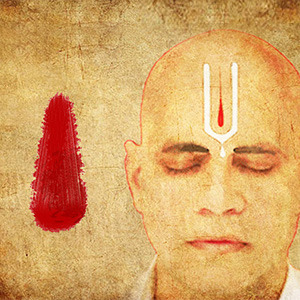
It's basically for strength, bravery and victory
The main difference in a bindi and tilak is the intent:
Bindi is for beauty
Tilak is for valour
Which. For a HERO. Just. Chef's kiss.
2. the markings around his eyes!!
I'm sure this has been said before, but it's very very reminiscent of kathakali makeup.
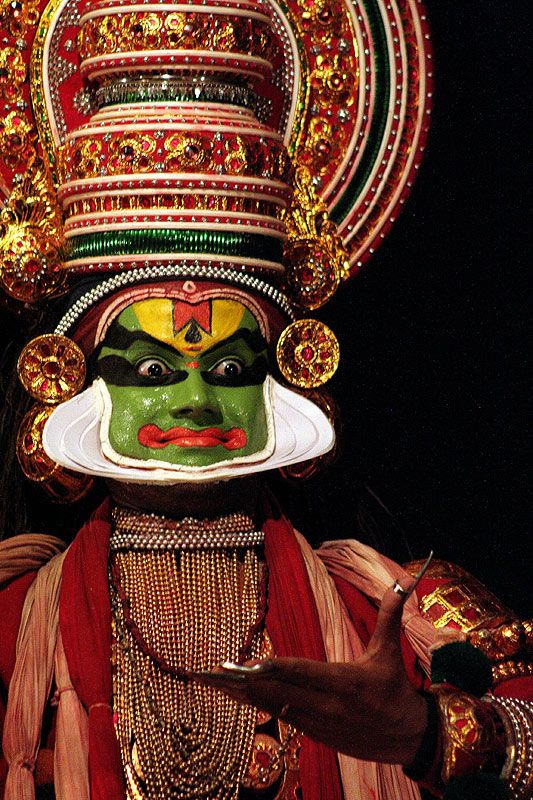
Regionally there's a lot of eye makeup stuff also btw. There are some absolutely beautiful tribal designs and regional designs with a lot of colours but I cant remember specifics rn
Also!! The very distinctive black lines around Pav's eyes?? I love them sm bc they feel so so based in kohl and kajal. Another huge beauty and often pride related thing.
There's even a whole thing where a mother or older sister will often rub a bit of her kohl off on her fingertip and press it behind their loved one's ear so that "buri nazar na lage" (no one's bad gaze catches you). It's called a kaala teeka
The idea being that you're so beautiful and/or cute and bright and lovable and nothing should jinx that and nothing bad should happen to you. It's very rare now and I've never experienced it myself but it's so so precious <33
3. the white markings on his cheeks!
I've seen that explanation of how it's reminiscent of Ganesha, the elephant headed god who is kind of a symbol of new beginnings, intelligence, prosperity, and a ton of stuff I don't even know how to explain honestly, but he's very cool and beloved and has a lot of Good Vibes™ and i love him basically.
I personally am reminded more of kathakali makeup again!! But that explanation is very cool too and i like it!! I don't know if I agree bc i think it m i g h t be a blasphemy to have that imagery on your face, afaik no one here does it for any reasons and we have literal festivals and pujas dedicated to Ganesha
But then again I am a human with limited knowledge and i don't know everything
I personally think the tusk like designs are very cool. However, I also think it would be a bit of a No No for religious reasons. I also think it reminds me more of classical dance face makeup and stuff.
I also think if they meant to make it a Ganesha reference, then he should only have a tusk on one side, bc there's a huge deal about Ganesha being "ekdanta" (transl: one toothed) bc he has a well known myth of breaking off one of his tusks to write a mythologically and culturally significant epic.
There are also a lot of actual cultural face painting things in India that are way cooler than the Ganesha thing in my opinion. So while that theory is cool, I don't personally agree with it. I could be wrong, again, idk what the design intent was exactly.
No. 3:
Next thing: this is a very very small thing and i only have a sentence on it, but i really appreciate Pav's neckline in his suit.
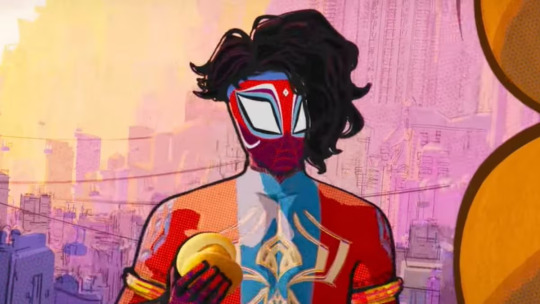
The neckline here? That's the kind of cut that's most typical of kurtas. Especially more ceremonial, kingly, wedding sherwani, or generally festive attire; a regular kurti might have a v-neck or something, but this curved collar? Very Indian and classy in a way I can't fully explain.
No. 4:
This next thing I'm going to go completely ballistic about, everyone hold on to your seats!!!
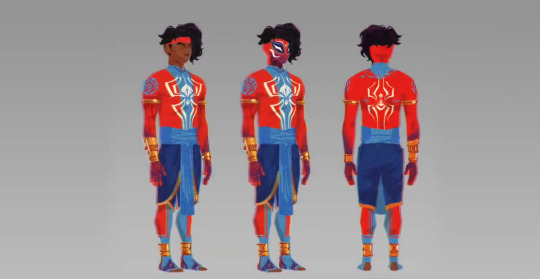
THE FUCKING MOTIF ON HIS UPPER ARMS. IT'S EVEN ON THE MEHENDI-ISH PATTERN ON HIS WRISTS AND HANDS. THE SPIDER SHAPE TOO. I AM NOT NORMAL OKAY
LISTEN.
LISTEN TO ME
TBIS IS CONFIRMATION THAT KRISHNA PAVITR IS CANON
HE IS SO SO KRISHNA CODED
Idc if I'm delusional, i DARE you to look at that blue design and tell me it doesn't look like a peacock feather
THE SHAPE OF HIS FUCKING SPIDER IS OH SO SUBTLY CURVED TO BE PEACOCK FEATHER SHAPED TOO
There is no human way for me to be normal about this i need a minute
Okay for context:
Krishna is a very important and beloved god in Hinduism. I cannot overstate the love I have for him, even being mostly non religious myself.
There is SO MUCH about him he is such a big deal and thanks to him being made a character in popular Indian cartoons and so many animated and live action movies being made about him, he is literally woven in the fabric of our collective consciousness and love for our culture
He's a mischevious and fun and chaotic and lowkey antiestablishment kid deity. He contains the literal universe. He has a deep abiding love for his people and his family and loved ones and the world he serves. He is a dancer, flute player, sweetheart, lover of life. He has a thousand wives, yet one Radha who he never married but is his literal immortalized soulmate. He guides heroes to duty. He is full of wisdom but also silly hijinks. He is so so beloved.
The peacock feather is his symbol! You could see the peacock feather anywhere and it's immediately OH KRISHNA! He wears a peacock feather, famously. In all his iterations, from childhood to adulthood. Peacock feather is his emblem.
Krishna is depicted through the peacock feather. It's become a very common motif in arts like mehendi and various textile arts to have peacock feather and peacock patterns; I'm sure that existed before Krishna too in several cultural circles but he is definitely a huge part of it since. There is a chikankari motif that is very recognisable that's reminiscent of peacock feather but I'm mostly unsourced on that, going off my own interpretation
But there's a definite link between peacock feather=Krishna=inextricable part of culture and art.
At least in North India. He's less of a big deal the further south you go. Still very widespread and overall loved tho.
So anyway seeing that peacock feather type motif on Pav?? Mixed with his Spiderman identity??? Is so amazing to me.
Krishna coded Pavitr real ✨
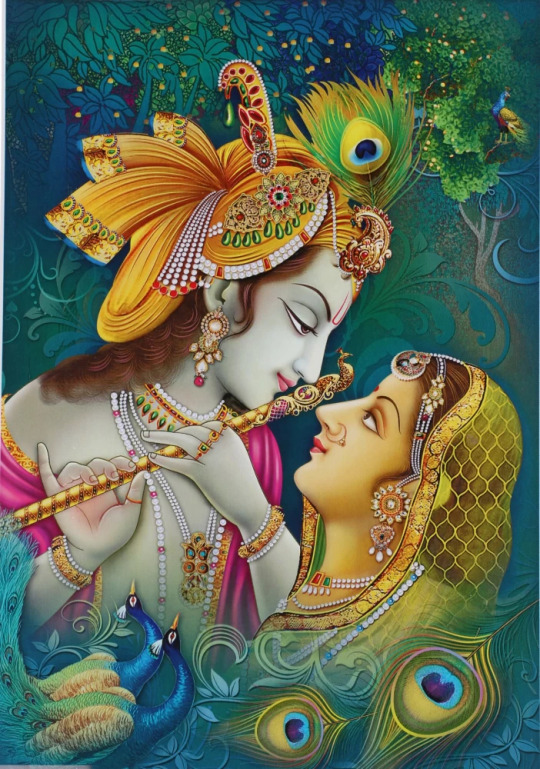
(Also yeah people have already pointed out that Pav's hand designs are based on mehendi so I don't need to go into that askjasjkas)
No. 5:
Also. Huge fan of his arm cuffs. It's just another Indian warrior thing; often in ye olde times and in mythology, the cuff would be a lot simpler, often just a thread with an amulet to grant you protection. But it steadily became fancier, and now it can be decorative or a valour thing or both
Very often just decorative now actually. Often seen in weddings and ceremonies too
No. 6:
Okay about his bangles now:
I absolutely LOVE THEM I love them so much I am so obsessed with them actually!!
So. First of all
I remember there being a confusion in like earlier fics especially on whether they were bracelets or damrus or bangles or what
And i have Thoughts
So first of all
They are not damrus/damarus.
Damarus are a musical instrument made of wood and with two beaded ropes to beat on the small drum-like ends. They're also symbols of lord Shiva who uses a damaru.
They are very different from what Pav wears and i remember my fucking whiplash when earlier fics called his bangles damarus. I think i choked on my maggi.
I don't mean to be rude to the writers ofc, they were doing the best with what they knew. But it's just very jarring to me to hear that
I think an explanation I heard was that Pav's web shooter design was inspired by damarus? Which yeah I get that and I actually wanna talk about it bc I very much see it. But they are very much NOT damarus themselves
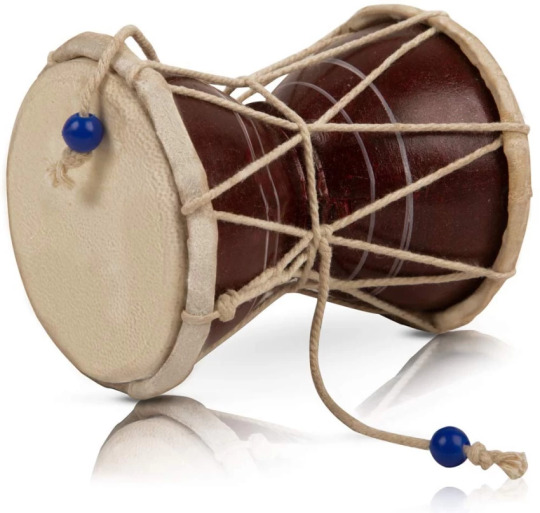
So
First of all i personally have never seen nor heard of the kind of bangles Pav wears which appear to have a strip of cloth in the middle? While being gold cuffs on both ends? Which is new and interesting actually and opens up aspects abt his character that i find really interesting
Bc first of all: that implies he made them himself from stuff he already had inspired by things he saw. It seems, at least to me, like he used bangles/kadas he had to make the shooters he uses, which are designed the way they are for easier slinging and his cool tricks with them which would be harder if they were solid gold, and also the shape when he does the cool yoyo-y trick and hits The Spot with it and everything is very damaru shape. Which is also pretty cool if it's meant as a reference to Shiva and his damaru (he's a very fierce god with the damaru) or a reference to the street performers who use it nowadays.
Either way - and also additionally the fact that PAV LITERALLY DOUBLED HIS BANGLES AS WEB SHOOTERS WHICH IS SO CREATIVE AND SMART - and developed his own whole signature skillset with it?? And made his own bangle/shooters as I said before????
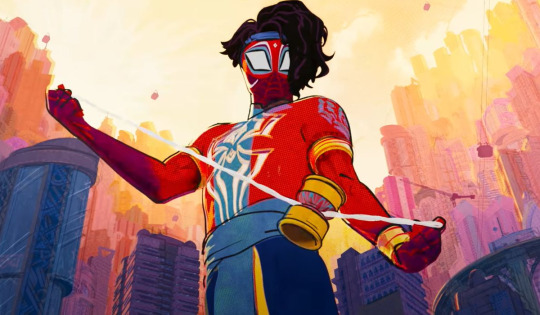
My boy is PEAK jugaadu
He is the embodiment of jugaad
Never has anything been so true to the Indian spirit than jugaad
Okay so for context, the jugaad that I keep talking about:
It basically means makeshifting and/or inventing stuff you need from the limited stuff you have. That's a very simple way of explaining it. Just imagine that, but up the silliness level x100.
For example, a guy jugaaded a showerhead by poking holes in a sprite bottle and putting a hose in it and routing it to the tap.
Jugaad can be both very smart, and very funny and silly
And it usually involves combining useless stuff/trash/just stuff you had lying around to make smth that you didn't wanna waste money buying, and often ends up having more functions than the stuff it was meant to replace. This but it's also very crackheaded. Like idk how to explain. It's basically makeshifting, but it's just developed into such an Indian Spirit Thing™ that we have a word for it
So i love that Pavitr's bangles do all of that. He is a true Indian boy to his core!
No. 7:
Okay I have thoughts on his dhoti too!
So.
Blue.
I know why they used blue for his dhoti, what with the spiderman colours, the need to complement his bright red with smth softer, and everything. I get it and i love it so so much. What I'm about to say next is not a complaint against this at all, it's very good design imo
But.
Everytime I look at him in his fucking blue dhoti
I just remember all the times my grandmother has apprehended me and made me go and change for trying to wear blue or black at a Puja
Bc they're apparently unholy colours ;_;
Basically yellow, saffron, red are the appropriate holy colours. Now that i think about it, I've never seen a god or mythological king depicted in a blue dhoti or generally blue clothing either - farthest they go from the three i described is pink or green
I never really thought about it until my Nani pointed it out. I'm still not sure if anyone except her even knew or cared about it.
But that is the memory that bonks me on the head every time i Perceive the blue dhoti
Bro upgraded from funeral colour (white, which is his dhoti in the comics and absolutely infuriates me on a visceral level) to unholy colour askaskjjska it's so funny to me
Purple was still a luxurious colour, but generally warmer and/or lighter colours are The Done Thing. It's an old notion and the cultural connotations are now very diluted by Western influence and also none of us Caring about a lot of it anymore (not necessarily a good or bad thing particularly)
Indigo also has. Loaded connotations.
Because Britain did a Colonialism and a lot of Indians suffered for it. It's a whole history lesson.
I would rather not get into the whole details but basically Indigo (the plant from which the dye was made) was a valuable commodity and Britishers essentially forced farmers to grow only that, ignoring their need to grow food or sustenance or care for the land in general, especially in the Bihar-UP regions. There were eventually a lot of revolts where many people, esp farmers, died.
Basically a double whammy of starvation and death as a direct result of colonialism. It was a major part, historically, that sparked rage for the freedom movement
If you wanna learn more abt it you can search up Champaran farmer revolts!
Also about the drape of Pav's dhoti:

I've seen a couple of memes and reels abt how Pav, in an emergency, suiting up for Spiderman duty, would be taking an hour to drape the dhoti and stuff
And those are hilarious and i love them
But also
That's literally not even a proper dhoti -
So the thing pav wears is basically more of dhoti-pants with a cummerbund.
So okay I need to explain this better hold on
A dhoti is basically a sheet of fabric that is draped around the waist and down. The elaborateness of the cloth can vary vastly from intricately patterned silk and brocade, to plain white cotton with a thin gold border optional
The drape of the dhoti varies even more depending on region, occasion, occupation, and status. You can have everything from the casual simple towel like drape and tuck that some men wear to relax on a daily basis, to an intricate thing with many folds and pleats and tucks and the middle part that hangs (I forget the name for that) that would actually legitimately take hours and is often adorned with jewellery . To a thing that's flexible to move in and also looks very pretty and is genderneutral some dance forms call for.
Basically. The drape varies vastly. And it's all one cloth, maybe a second one for a separate cummerbund sometimes, I'm not that well versed abt dhotis tbh.
But the thing Pav wears?? It doesn't seem to me to be folded the way I've ever seen any dhoti
The way it's folded and shaped is not how those style of dhotis work. There would be a lot more pleats and folds, for one. But it's not shaped the way to match the less-folded dhotis either.
Now, I'm no dhoti expert, but that leads me to believe that's not a full on dhoti. What it's more likely to be is dhoti-pants
Dhoti pants are this fusion thing. It's in the name. I haven't seen it much but I know/think/am pretty sure its a thing, bc most Indian guys now don't know how to drape a dhoti either and it's a good solution. Worn like a pant, looks like a dhoti. Simple. A cummerbund for the middle drape, and you're set!
Also side note: the fold with the distinct two legs and the middle drape that Pav has? Is the most commonly depicted warrior and king drape,, at least in North and Middle India, I'm not as well versed about the South but I think it's the case there too. The gods are depicted in that drape too
I have fewer comments on his leg design, I like that it's reminiscent of mehendi even on his feet bc yeah that's also done on the feet, although rarer now and also a bridal thing
No. 7:
He has gold cuffs on his ankles that I really like!
Okay so here's the interesting thing:
I could be wrong, but
But that kind of thick ankle cuff is not actually an Indian thing?? At least not in the warrior hero context that a lot of his design seems based on. At least not of that shape and width.
What we do have though are very simple metal ankle cuffs put on (I think) one ankle of young kids for protection,, again a tradition I'm not very familiar with, it's more localised
The other thing we have that's more interesting tho:
We have payals and ghungroos!!! Which opens up so many exciting prospects to me because those are both dancer things
Like. The payals are ornamental. They are beauty things as well. All women would wear them, their elaborateness and style depending on status, money, and region ofc
They double as dance and performance things too ofc
But ghungroos are specifically dance things
Very very sacred and honoured to the dancers, too. Quite personal
(These are all little bells on the ghungroos btw!! Hundreds of them. They ring out when the dancers dance)
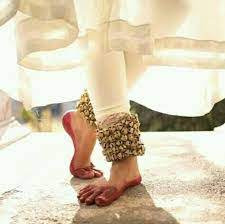
This is what Pav's ankle cuffs most remind me of. It's not the same thing ofc, and idk if the designers were even thinking of this.
But it would be really cool if he was inspired by ghungroos to have cuffs of similar thickness and placement on his legs. Perhaps even familiar to him hmmm?
This is me theorizing HARD to support my headcanon, but combined with Pav's classical dance-n-martial-arts-y moves, i present to you: Pav learning classical dance when he was younger (a thing that a lot of Indian kids do and only a few seriously continue for their lives) is real.
I rest my case
Like yeah it's known at this point that Pav's moves are based a lot off the martial art of kalaripayattu. Which is SO AMAZING AND I LOVE IT SO MUCH!!! But I also think this would be a cool influence alongside that, bc it really feels visible too.
No. 8:
The fact that Pavitr is barefoot is so so important and dear to me!!!
In Indian culture, you're supposed to take your shoes off as a mark of respect, before entering the ranabhoomi (literal transl: battleground, but not in an actual war with swords and shit ofc)
Being barefoot for pujas and in temples and on sacred ground in general is very important
As is being barefoot when you're walking onto a kabaddi or wrestling ground,, basically any fight that's supposed to be important and/or with honour. It's a respect thing for the opponent and for the earth you fight on.
There are a lot of contexts where being barefoot is important or a given
There's the prayer ground bc it's sacred and holy and you can't be dragging your dirty ass shoes there it's super disrespectful. You gotta enter with clean feet specifically, dirty feet are considered disrespectful too. that's also why there wil often be feet washing areas outside of temples here
Then there's the ranabhoomi that I just said, which is more of respect for your opponent and the earth. Respect to the earth especially is very important in the combat forms and sports I know of at least
Then there's the basic respect and tbh the hygiene thing too, of always taking off your footwear before entering another persons house. That one is more flexible, sometimes you can take it off inside, but the done thing is to take them off outside generally. Especially if you're a guest who's not particularly close. You'd be considered really rude if you didn't take them off at all. But again that still varies by person,, the older generations are way stricter abt it
Then the bride thing,,, it's actually a whole small ritual. The bride and groom will enter the groom's house for the first time,, which is considered the bride's new home bc misogynistic tradition so yeah. But basically it's supposed to be an auspicious beginning to a new home and life. (Btw being barefoot during the wedding ceremony is also generally required)
Usually, at least in North Indian tradition, a small vessel of rice is kept at the threshold that the bride must tip over with her foot when entering. It's for prosperity. Then she steps directly into a plate of a red liquid I forget the word for, but it's basically a sindoor paste type of thing. Her first steps into the house must be taken leaving those red footprints behind. That's for auspicious beginning
So Pavitr being barefoot is so so cool from a cultural and a character building standpoint
He takes his job seriously, he does it with respect and honour!!! He seems so chill and happy go lucky, but he's deliberate and respectful abt it!! And he's super connected to his culture too, bc you could just Not and no one would care, but it's so important that he does!!
So yeah!
That has been my full ramble askjasjkas. If you made it this far, have a cookie! Thank you and I hope this was interesting <33
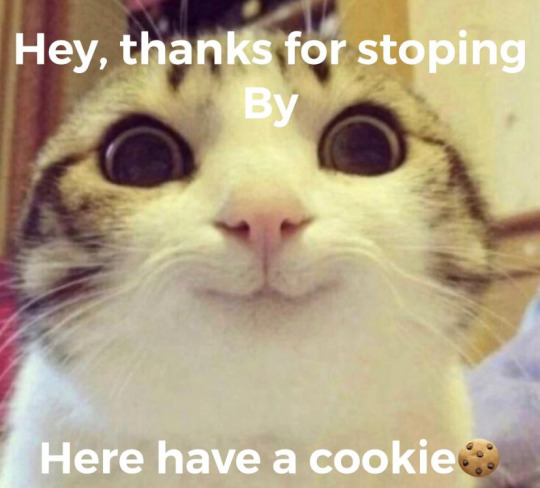
#pavitr prabhakar#atsv pavitr#spiderverse pavitr#spiderman atsv#across the spiderverse#spider man: across the spider verse#character design#rant#starr rambles#analysis#design analysis#character analysis#culture#indian culture#cultural references#pavitr my beloved#myths and legends#chaipunk#goldenpunk#spiderman india#india love#indian#long post
576 notes
·
View notes
Text










Thomas Hart Benton (1889-1975, American)
Born in Missouri into a politically influential family in 1889, Benton found inspiration among working class communities in rural America. A prolific painter, sculptor, printmaker and gifted storyteller, Benton is credited with leading the Regionalist movement in the United States early in his career. He has long been celebrated as the most innovative practitioner of mural painting depicting American life.
Benton studied at prestigious institutions including the Art Institute of Chicago in 1907 and the Académie Julian in Paris, where he met fellow American painter, Synchromist Stanton Macdonald-Wright. Settling in New York in 1911, Benton’s work remained largely abstract until the early 1920s. On a 1924 trip home to visit his father, he was inspired to revisit his midwestern roots and began painting American rural subjects such as life in coal mines, steel mills and cotton fields. The influence of Spanish Old Master El Greco is evident in Benton’s naturalistic style, sculpted figures and fluid lines. While the rhythmic distortions of Benton’s compositions were informed by his European study, his work reflects a vibrant diversity that is distinctly American.
Benton was the first artist to be featured on the cover of Time magazine and his murals hung at an early site of the Whitney Museum of American Art. It was during this time that Benton formed a close alliance with his student - and frequent guest at his Martha’s Vineyard studio - Jackson Pollock.
https://schoelkopfgallery.com/art.../129-thomas-hart-benton/
25 notes
·
View notes
Note
hi, i hope you're doing okay. i'm sorry to ask this - but considering you made a switch from hellenic to brythonic/irish paganism, i was wondering if you had any advice for me. i'm worshipping many hellenic gods, and my shrines are overflowing with statues and devotions build up over many years. and yet i feel the pull of welsh deities - i have had one in particular reach out - and i find myself overwhelmed. i want to explore this new path, without the old feeling either 1) abandoned, 2) unworthy of my attention, or 3) forced if i can't beat the anxiety of the former 2 options. How did you tackle this? What was your experience? Thank you for your time.
Ooo this is a good question!
Alright, so, my main switch happened during a pretty sizable break I was taking from religion in general, when I was very burnt out and stressed, but I did incorporate some Celtic deities into my practice before that switch happened— namely Arawn, who I found out had been a presence in my life since I was young but I hadn’t been able to name him, and also the Dagda and the Morrígan.
My advice to incorporating these new deities is to get into the mindset of an ancient polytheist. When a Roman soldier went to Brittania and sacrificed to the new gods he met, he wasn’t abandoning his old ones— he simply made more room for them on his altar. Also, he didn’t necessarily have a super deep complex relationship with every deity he ever honored. He may have offered or prayed a few times to one for a specific reason.
The reason we associate gods with different concepts or things is because we need them in different spheres of our lives. We, as humans, are always growing, always changing, and as pagans we are going to naturally gravitate away from certain gods and go towards new ones. We may return to the old ones eventually. The gods understand this. I always think about it like my relationships with other humans. I have childhood best friends that I grew apart from, whether because of circumstance or because we just naturally parted, but despite the fact I don’t talk to them I still think of them fondly and appreciate the memories of them because they helped make me who I am today. One thing I did to ease the process was to do a new moon ritual where I thanked my “old” gods for all they did for me before I formally welcomed my “new” hearth cult.
One advantage of moving towards celtpol as a helpol rather than something else is the fact that there is… pretty much zero way to correctly practice celtpol from a reconstructionist perspective. If you are used to a certain style or process of ritual and/or worship, you can keep doing that. There’s no need to replace a working part of your practice when there is literally nothing to replace it with, lol.
Just some general advice for dealing with Celtic deities: you will have to rely on UPG a lot. Read the Mabinogion, read the Irish Cycles, wherever your deities are found. Read them multiple times, take notes. Eventually you will start to associate certain things with them. The archaeology just isn’t there like it is with classical religion, so there’s much less academic stuff out there if you’re used to that sort of thing. You will have to do a lot of extrapolation and put in the work.
One helpful resource I enjoyed from a contemporary perspective was Morgan Daimler’s Irish paganism books, she is one of the only Celtpol authors I trust and enjoy. Unfortunately there’s not really a Brythonic equivalent for her stuff, although maybe we’ll get one someday.
In terms of celtpol community, you’ll find it’s a lot lonelier than the helpol community. There’s just simply not many of us, and also we all just have radically different beliefs. There’s basically nothing that’s agreed upon. You’ll have celtpols who are very regionalist, anti-woo, etc. and you’ll have celtpols who are hyper-syncretist, very woo-y and whatnot. I’m in America, so it might be different for real-life communities in Ireland/the UK if that’s where you are.
Thank you so much for the question, nonnie <3 I wish you good luck on all your journeys, and please feel free to reach out again with asks or DMs if you have any other questions!
#asks#dara asks#celtpol#helpol#celtic paganism#brythonic polytheism#irish polytheism#hellenic polytheism#pagan
10 notes
·
View notes
Text
I bought a piece of clothing that sort of looks like a traditional costume of the region i was born and currently live in. The challenge is how do i style it without looking like i'm cosplaying my own culture or like i'm really really regionalist and possibly racist :/
5 notes
·
View notes
Text



Marvin Dorwart Cone (1891 – 1965) American painter in the regionalist style.
Cone was born in Cedar Rapids, Iowa, and lived there most of his life. He graduated from Washington High School in 1910. Cone attended college and traveled to Paris with his contemporary and high-school friend, Grant Wood.[2] After his return to the United States, Cone helped to found the Stone City Art Colony. He was a professor at Coe College for more than forty years. Most of his paintings can now be seen at the Cedar Rapids Museum of Art. Some of his sketches can also been found in the permanent collection of the University of Northern Iowa Gallery of Art in Cedar Falls. "Untitled (Interior)," a painted scene of doors in an interior, can be seen at the Blanden Memorial Art Museum in Fort Dodge.


/ Marvin Cone, Habitation, 1938 -39
5K notes
·
View notes
Text
Andrew wyeth

American visual artist, primarily a realist painter, working predominantly in a regionalist style.
Many of Wyeth's subjects were neighbors and locales in his surrounding area, as he generally kept close to home. Wyeth became famed for the quality of realism and detail found in his art, often creating moody pastorals, while also being blasted by some critics for his lack of avant-garde cred.

Gregory Crewdson

Gregory Crewdson’s photographs have entered the American visual lexicon, taking their place alongside the paintings of Edward Hopper and the films of Alfred Hitchcock and David Lynch as indelible evocations of a silent psychological interzone between the everyday and the uncanny.
His surreal images are often melancholic, offering ambiguous narrative suggestions and blurring the boundaries between fiction and reality. Working with large production teams to scout and shoot his images, his photographs have become increasingly complex as if it were for a motion picture production

Reading into Crewdson's work, this is the essence I'm hoping to achieve with my work. I think there's something melancholic about my film. I think loneliness is a sad topic. I've kept it unknown as to why the character has been driven to this point, which leaves a bit of mystery, like these images. Crewdson's work has a lonely feel to it. You feel bad for the people in the image, who all seem to be stood alone.
My favourite image I've found of his is this image below. It has the same feeling of melancholy and loneliness like the other images, but there's some supernatural about it with the spotlight, almost like it's coming from something alien. Which matches my film nicely as it also has a supernatural feel to it with the strange figure and red box.

0 notes
Text
Virtual Sketchbook 4
In his life before fame, Jackson Pollock studied under the regionalist painter Thomas Hart Benton for about three years. After this period in his life the country would enter into The Great Depression, and Pollock would work as a painter under the WPA Federal Art Project creating artworks commissioned by the government. This job was the only way he was able to earn an income and survive through this period of poverty. Creating art out of passion is a beautiful thing, but at this point in his life, he was creating art out of necessity. This would lead to the harsh abuse of alcohol, which Pollock would receive treatment for over a few years until he decided to escape the city life and move out to a more rural area. Once he freed himself from his vices and obligations, he was finally able to express himself though clear though and would create the greatest works of his life in his own personal expressive style.

0 notes
Text
SKETCHBOOK #4
Jackson Pollock’s journey from studying with Thomas Hart Benton to creating his iconic drip paintings represents a profound evolution in his approach to art. Early in his career, Pollock was heavily influenced by Benton’s style, which was focused on representational, regionalist themes. However, as Pollock’s own artistic voice developed, he expressed his feelings in a way that was less constrained by form and narrative. More inspired by the surrealist idea of tapping into the subconscious, Pollock began experimenting with abstract forms, and he found freedom in a process that involved movement and immersion. This shift allowed Pollock to convey emotion, energy, and chaos directly without the need for recognizable imagery. His transition to “drip” painting was not accidental. It was a deliberate and meaningful choice that reflected his desire to engage with the canvas on a deeper, more physical level. Instead of using a brush traditionally, he began pouring and splattering paint, allowing his entire body to become part of the process. This technique, known as Action Painting, emphasizes the act of creation itself rather than focusing on a specific subject. By removing all recognizable forms, Pollock was able to create a pure expression of emotion and motion. In doing so, Pollock redefined painting and pushed art beyond mere representation. Inviting audiences to confront the raw energy of existence, his works became a mirror of the human psyche.
2.

0 notes
Text
virtual sketchbook 4
Jackson Pollock’s transformation from figurative imagery to the radical abstraction of his "drip" paintings was a gradual and intentional evolution, which was influenced by various artistic and personal factors. Early in his career, Pollock studied under Thomas Hart Benton, a regionalist artist known for his dynamic, figurative murals that emphasized movement and narrative. Though Benton’s work emphasized a clear, representational style, Pollock was increasingly drawn to abstraction, exploring the possibilities of conveying energy and emotion without relying on recognizable imagery.
Pollock’s exposure to the European avant-garde, particularly the Surrealist movement and its emphasis on unconscious expression, was pivotal in shaping his transition. The idea of spontaneous, unplanned mark-making influenced Pollock’s approach, especially after his involvement with the New York School of Abstract Expressionism. He began to embrace the idea of painting as a physical act, one that could capture emotion and unconscious drives through gesture and rhythm, rather than focusing on the depiction of tangible subjects.
Pollock's embrace of abstraction was also personal, as he grappled with psychological struggles and sought to express his inner turmoil and complexities. The "drip" technique that became his signature was developed through years of experimentation, particularly after Pollock began using liquid paint and working on large canvases placed on the floor. This method allowed him to engage with the painting process in an immersive, almost ritualistic way, creating a direct and unmediated connection between his body and the canvas.
Ultimately, Pollock’s move toward the complete removal of recognizable imagery was a conscious rejection of traditional artistic constraints. His "drip" paintings are a testament to the belief that art could transcend representation and communicate more directly through form, color, and movement, allowing the viewer to experience the artist’s emotional and physical presence within the work itself.

0 notes
Text
Is attending art school necessary to become an artist?
Jean-Michel Basquiat did not attend formal art school. Instead, he was largely self-taught and became known as part of the street art scene in New York City in the late 1970s and early 1980s. He gained prominence through his graffiti work under the pseudonym "SAMO" and later transitioned to more formal art settings, becoming a major figure in the neo-expressionist movement. His raw talent, distinctive style, and bold commentary on issues such as race and class distinguished him as a powerful force in contemporary art without traditional academic training.
Andy Warhol did receive formal art education. He studied commercial art at Carnegie Institute of Technology (now Carnegie Mellon University) in Pittsburgh, graduating in 1949 with a degree in pictorial design. His education and subsequent work as a commercial illustrator greatly influenced his later artistic style and approach, particularly in his role as a leading figure of the Pop Art movement. Warhol's use of mass production techniques, celebrity culture, and commercial imagery are often attributed to his early professional experiences and training.
Jackson Pollock did attend formal art school. He studied at the Art Students League of New York, where he was taught by Thomas Hart Benton, a leading American regionalist painter. Benton’s focus on rhythmic and dynamic compositions influenced Pollock's early work, although Pollock later developed his unique style, breaking away from his mentor’s realism. Pollock became known for his groundbreaking drip and action painting techniques, making him one of the most significant figures in abstract expressionism.
David Hockney attended art school and had a formal education in the arts. He studied at the Bradford College of Art in his hometown in England and later attended the Royal College of Art in London. Hockney gained recognition during his time at the Royal College, becoming a leading figure in the British Pop Art movement. His formal training helped him experiment with various media and styles, making him one of the most versatile and influential artists of the 20th and 21st centuries.
By ChatGPT
#jean michel basquiat#Basquiat#andy warhol#jackson pollock#david hockney#art#artist#Art school#Art student#education#Abstract#pop art#expressionism#painting#drawing#realism#Abstract artist#quote of the day#quotes
1 note
·
View note
Text
Virtual Sketchbook #4:
1. WRITING, THINKING AND LOOKING CRITICALLY:
Jackson Pollock’s journey from studying with Thomas Hart Benton to creating his iconic drip paintings involved a shift from abstract imagery to complete abstraction. While under Benton’s support, Pollock was exposed to the fluidity and rhythm of the American Regionalist style, which influenced his early works that contained reoccurring figurative elements. However, exposure to Surrealist ideas and their focus on automatism prompted him to explore new approaches. So, Jackson Pollock had a break from traditional imagery which became apparent when he adopted the drip technique in his art. This involves poured or dripped paint onto a canvas laid on the floor. This method allowed for a more direct and physical engagement with the painting process, emphasizing a natural movement of the artist. Through this process, he transitioned from using abstract imagery to creating entirely abstract compositions, ultimately leading to his iconic “drip” paintings that embody Abstract Expressionism.
2. ART PROJECT - digital artwork

Ode to all the chaos in my mind of all the things I need to do.
0 notes
Text
Andrew Newell Wyeth (July 12, 1917 – January 16, 2009) was an American visual artist, primarily a realist painter, working predominantly in a regionalist style. He believed he was also an abstractionist, portraying subjects in a new, meaningful way. The son of N. C. Wyeth and father of Jamie Wyeth, he was one of the best-known U.S. artists of the middle 20th century.

Dryad
Andrew Wyeth
349 notes
·
View notes
Text
WRITING, THINKING AND LOOKING CRITICALLY
Jackson Pollock's evolution from studying with Thomas Hart Benton to pioneering his famous "drip" paintings involved a profound shift in his artistic approach and philosophical stance towards art. Initially influenced by Benton's regionalist style and figurative imagery, Pollock gradually began to break away from representational forms. This transition was marked by his exploration of abstract imagery, where he experimented with elements of form and color divorced from recognizable subject matter. However, it was his experimentation with the drip technique that culminated in the complete removal of imagery from his paintings. By allowing paint to drip, splatter, and flow freely onto the canvas, Pollock embraced spontaneity and chance, prioritizing the act of painting itself over any predetermined imagery. This shift towards non-representational expression allowed Pollock to delve deeper into the emotional and psychological dimensions of art, creating works that embodied raw energy and pure abstraction.
2. ART PROJECT
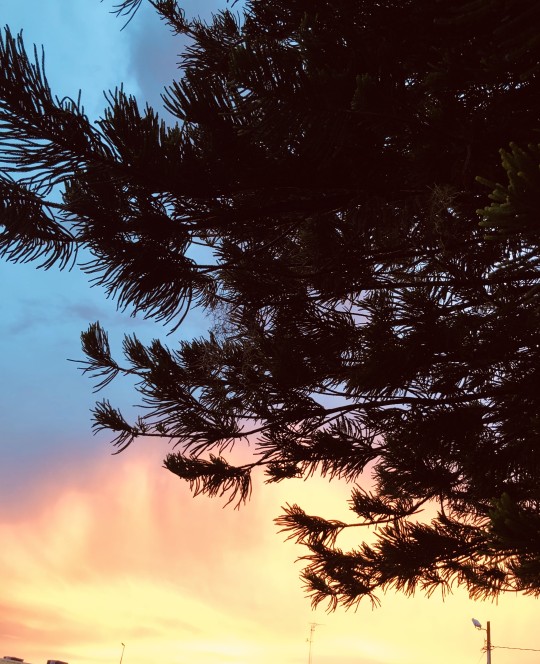
Title: Whispering Twilight
Description: In "Whispering Twilight," the evening sky becomes a canvas for the dance of light and shadow. The silhouette of the pine branches against the pastel hues of the sunset creates a captivating contrast, inviting viewers into a realm of quiet introspection. Abstract shapes and swirls blend seamlessly with the natural elements, blurring the lines between reality and imagination. As the day transitions into night, "Whispering Twilight" captures the fleeting beauty of the moment, where nature whispers its secrets to those who pause to listen.
0 notes
Text
VIRTUAL SKETCHBOOK # 4
1. WRITING, THINKING AND LOOKING CRITICALLY
Jackson Pollock's evolution from studying with Thomas Hart Benton to pioneering his famous "drip" paintings involved a profound shift in his artistic approach and philosophical stance towards art. Initially influenced by Benton's regionalist style and figurative imagery, Pollock gradually began to break away from representational forms. This transition was marked by his exploration of abstract imagery, where he experimented with elements of form and color divorced from recognizable subject matter. However, it was his experimentation with the drip technique that culminated in the complete removal of imagery from his paintings. By allowing paint to drip, splatter, and flow freely onto the canvas, Pollock embraced spontaneity and chance, prioritizing the act of painting itself over any predetermined imagery. This shift towards non-representational expression allowed Pollock to delve deeper into the emotional and psychological dimensions of art, creating works that embodied raw energy and pure abstraction.
2. ART PROJECT
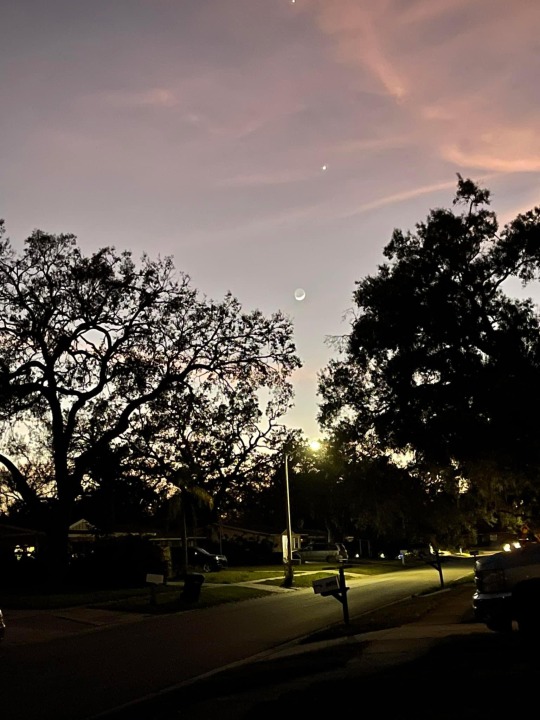
Title: Celestial Harmony
This artwork captures the ethereal beauty of the evening sky, infused with a sense of tranquility and wonder. The interplay of light and shadow creates a mesmerizing contrast, while the soft hues of pink and purple evoke a feeling of serenity. The crescent moon and stars emerge as focal points, symbolizing the vastness of the cosmos and our connection to the universe. Abstract swirls and brushstrokes add a dynamic energy to the composition, mirroring the ever-changing nature of the night sky. Overall, "Celestial Harmony" invites viewers to contemplate the mysteries of the cosmos and find solace in its timeless elegance.
0 notes
Text
How did Jackson Pollock go from studying with Thomas Hart Benton and using abstract imagery in his paintings to removing all imagery in his famous “drip” paintings?
Early Influences and Training: Pollock trained under Thomas Hart Benton, a renowned artist recognized for his regionalist style and murals. Benton's influence may be observed in Pollock's early works, which had more figurative and representational elements. During this time, Pollock learnt about the effect of large-scale paintings and absorbed Benton's theories on picture space1.
Pollock's shift towards abstraction began in the early 1940s, as he abandoned specific figures and shapes. He completely covered his paintings with markings, ultimately shifting to a more abstract style. His painting technique became known as "action painting," which was distinguished by spontaneous, vigorous brushwork and an emphasis on the physical process of making art.
In his Drip Paintings, Pollock deviated from standard equipment including brushes, palettes, and easels, leading to his breakthrough. Instead, he used a flat canvas and let his imagination flow in the moment. This is when he created his well-known "drip" paintings. Pollock would stand over a horizontally positioned canvas and drip or spatter paint over it. The results were dynamic, chaotic, and devoid of any identifiable imagery. Pollock reinvented radical abstract expressionism by deleting all representational aspects. His groundbreaking method separated line and color, fundamentally redefining the definitions of drawing and painting. These paintings were famous, ushering in a new way of thinking about and seeing art.
In summary, Jackson Pollock's path from studying under Thomas Hart Benton to developing his drip paintings was a gradual movement from realism to abstraction, ending in a pioneering creative style that continues to captivate audiences today.
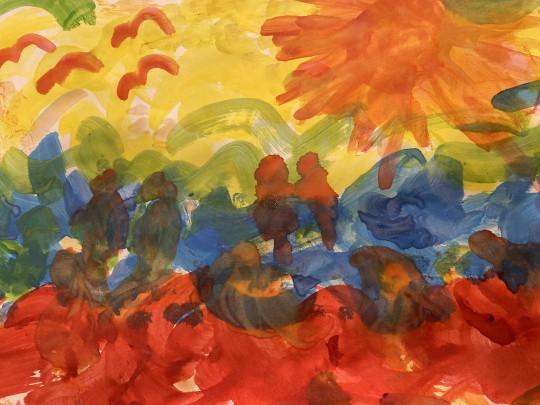
0 notes